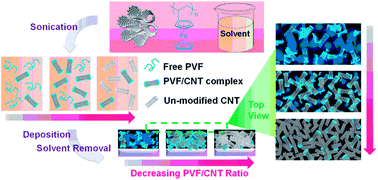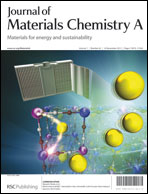Metallocene/carbon hybrids prepared by a solution process for supercapacitor applications†
Abstract
Efficient and scalable solution-based processes are not generally available to integrate well-studied pseudocapacitive materials (i.e., metal oxides and conducting polymers) with other components such as porous carbon, mainly because these classes of pseudocapacitive systems have poor solubilities in solvents and exhibit no specific interactions with the other component. Here we report, for the first time, the integration of a metallocene polymer, polyvinylferrocene (PVF), with carbon nanotubes (CNTs) via a simple solution process for supercapacitor applications. The solution processability of the PVF/CNT hybrid is due to the high solubilities of PVF in organic solvents and the unique ability of the metallocene/carbon system to form stable dispersions through the π–π stacking interactions between the two components. The nanostructure and electrochemical properties of the hybrid can be manipulated systematically by adjusting the composition of the dispersion. The hybrid with the optimized composition exhibits unusually high capacitance (1452 F g−1) and energy density (79.5 W h kg−1) obtained in a standard two-electrode configuration, outperforming previously reported pseudocapacitive materials.


 Please wait while we load your content...
Please wait while we load your content...